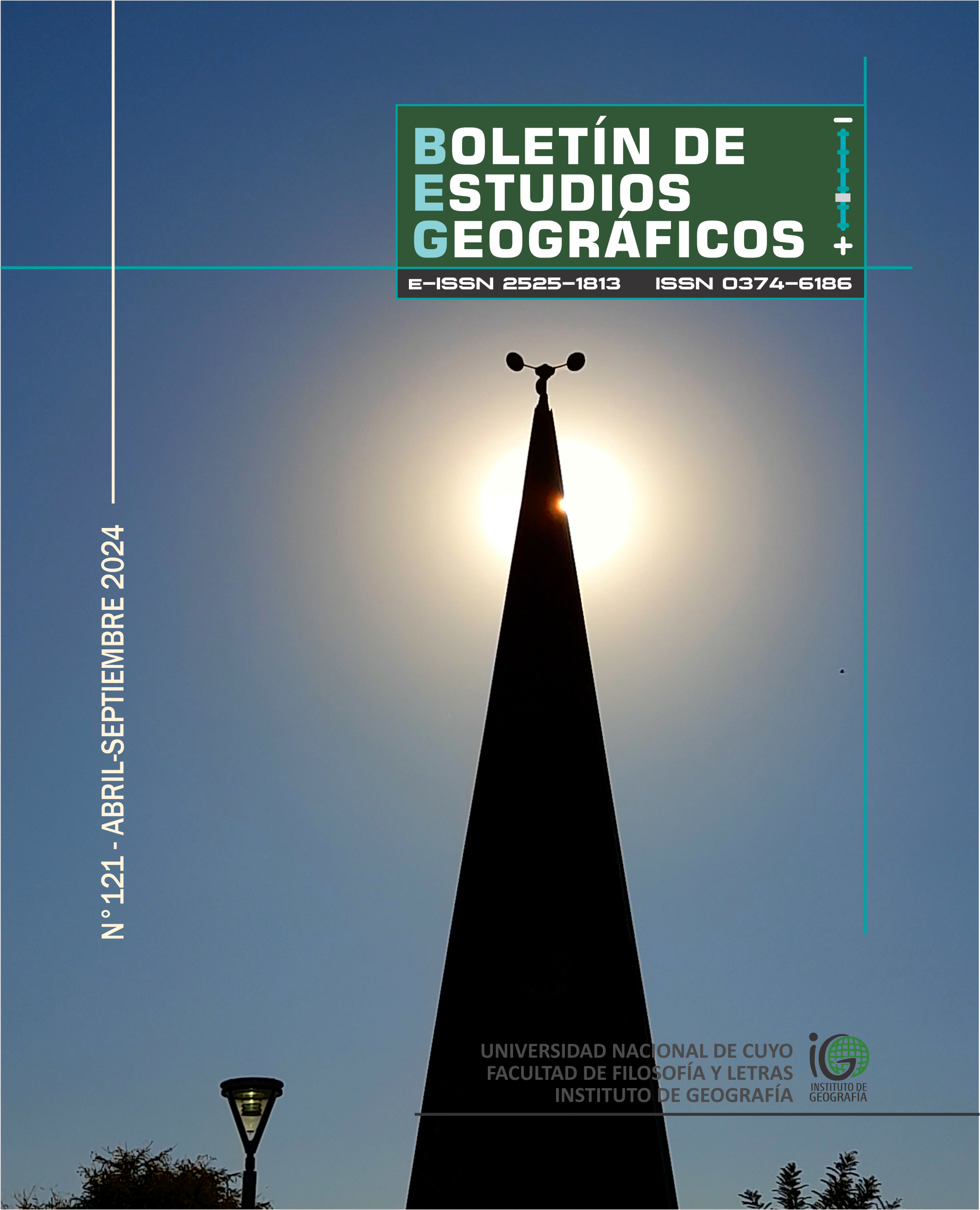SIG/Tecnologías y vulnerabilidad socio-natural
Un llamado a la investigación geográfica sobre los Andes Sudamericanos
DOI:
https://doi.org/10.48162/rev.40.046Palabras clave:
Andes, Sistemas de información geográfica, vulnerabilidad, geografía humana, geografía física, investigación de la montaña, cambio climático, tecnologías geoespaciales, SIGResumen
Desde un cuerpo seleccionado de publicaciones en inglés, este ensayo explora la relación SIG tecnologías y vulnerabilidad con el fin de contribuir a la investigación geográfica enfocada en los Andes. Tras una breve descripción del espacio y problemática climática que se le relaciona, se presentan algunas tecnologías geoespaciales, la articulación de éstas con un concepto de vulnerabilidad que se ha venido desarrollando a lo largo del presente siglo y el análisis de estudios de caso que investigan el sistema geográfico andino.
El documento concluye que, en el marco de los impactos que viene generando el cambio climático, estos avances allanan el camino y convocan a la ejecución de estudios integrales sobre vulnerabilidad en los Andes que consideren simultáneamente lo social, lo natural y el espacio específico de estudio que se investiga. Los recursos en términos de herramientas geoespaciales, conceptuales, de escalas, y de resultados aquí presentados pueden contribuir a orientar y servir como insumos en investigaciones relacionadas con el tópico tratado.
Citas
Borsdorf, A., Stadel, C., Borsdorf, A., & Stadel, C. (2015). Rural and urban settlements. The Andes: A Geographical Portrait, 155-202.
Castellanos, E. J., Lemos, M. F., Astigarraga, L., Chacón, N., Cuvi, N., Huggel, C., & Rusticucci, M. (2022). Central and South America. Cambridge University Press.
Cutter, S., Jerry, M., & Scott, M. (2000). Revealing the Vulnerability of People and Places: A case study of georgetown county, South Carolina. Annals of the Association of American Geographers, 90(4), 2000, p. 713–737.
Huddleston, B., Ataman, E., & D'Ostiani, L. (2003). Towards a GIS based analysis of mountain environment and population (Vol. 1, No. 10, pp. 2-4). Rome: FAO.
Intergovernmental Panel on Climate Change (IPCC). (2023). Climate Change 2022 – Impacts, Adaptation and Vulnerability: Working Group II Contribution to the Sixth Assessment Report of the Intergovernmental Panel on Climate Change. Cambridge: Cambridge University Press.
Lü, G., Batty, M., Strobl, J., Lin, H., Zhu, A., & Chen, M. (2018). Reflections and speculations on the progress in Geographic Information Systems (GIS): a geographic perspective. International Journal of Geographical Information Science, 33(2), 346–367. https://doi.org/10.1080/13658816.2018. 1533136
Manfré, L. A., Hirata, E., Manson, S. M., Bonsal, D. B., Kernik, M., & Lambin, E. (2015). Geographic Information Systems and Remote Sensing. In J. D. Wright (Ed.), International Encyclopedia of the Social & Behavioral Sciences: Second Edition (Vol. 10, pp. 64-68). Elsevier Inc. https://doi.org/10.1016/B978-0-08-097086-8.91027-4
Mark, Bryan, M., French, A., Baraer, M., Carey, M., Bury, J., Young, K., Polk, M., Wigmore, O., Lagos, P., Crumley, R., McKenzie, J., Lautzk, L. (2017). Glacier loss and hydro-social risks in the Peruvian Andes. Global and Planetary Change 159 61–76. http://doi10.1108/IJCCSM-06-2013-0076
Metternicht, G., Sabelli, A. & Spensley, J. (2014). Climate change vulnerability, impact and adaptation assessment: Lessons from Latin America. International Journal of Climate Change Strategies and Management. 6. 442. .http://doi10.1108/IJCCSM-06-2013-0076
Paul, S. (2013). Vulnerability Concepts and its Application in Various Fields: A Review on Geographical Perspective. Journal of Life and Earth Science, 8: 63-81. https://doi.org/10.3329/jles.v8i0.20150
Peggion¸ M., Bernardini, A. & Masera, M. (2008). Geographic Information Systems and Risk Assessment. Luxemburg: European Commission; Joint Research Centre, Institute for the Protection and Security of the Citizen.
Pinos, J., and Quesada-Román, A. (2022). Flood Risk-Related Research Trends in Latin America and the Caribbean. Water 14 (10): 1-14. https://doi.org/10.3390/w14010010
Silva, J., Shinohara, E., Giannotti, M., Larocca, A., & Quintanilha, J. (2012). An Analysis of Geospatial Technologies for Risk and Natural Disaster Management. ISPRS Int. J. Geo-Inf. 2012, 1, 166-185. https://doi.org/10.3390/ijgi1020166
Watson, R., Zinyowera, M. & Moss, R. (1998). The Regional Impacts of Climate Change: An Assessment of Vulnerability. Cambridge, Cambridge University Press.
Zapata, E. (2014). Impact Analysis of Climate Change on Andean Crops. Master's thesis in geographic information systems, Universidad San Francisco de Quito, Quito.
Descargas
Publicado
Cómo citar
Número
Sección
Licencia
Derechos de autor 2024 Jhon Robert Arias Hernández

Esta obra está bajo una licencia internacional Creative Commons Atribución-NoComercial 4.0.



























